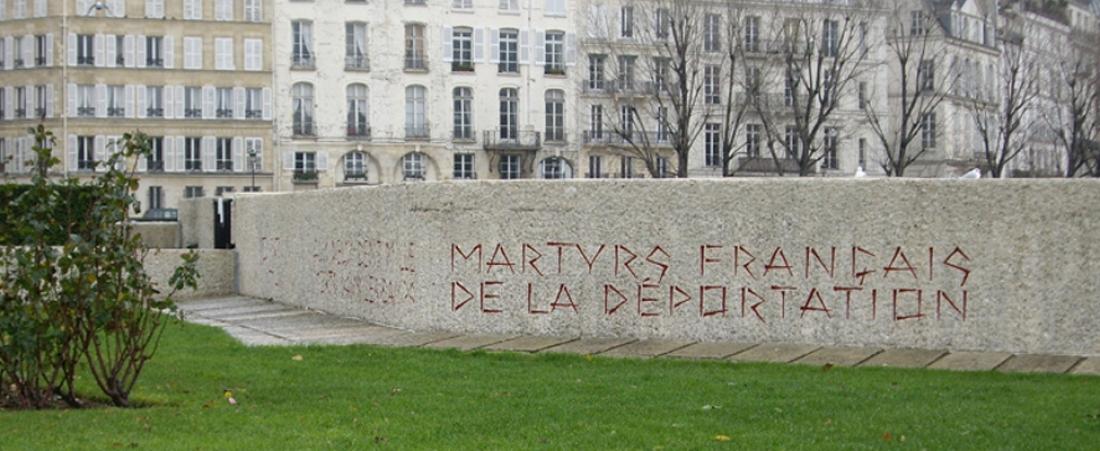National Deportation Day

A few years after the end of World War II (1939-1945), the French Republic decided to honour the memory of the victims of deportation, notably French deportees held in Nazi concentration or extermination camps.
Since the law was adopted on 14 April 1954, the last Sunday in April has been dedicated the ”National Day of Remembrance of the Victims and Heroes of Deportation”.
As soon as they came to power in January 1933, Adolf Hitler and the Nazis set up the first concentration camps in Germany. Dachau opened on 21 March 1933. Opponents to the regime, ”asocial” elements, everyone who did not fit into the National Socialist mould, were imprisoned there.
With German expansion in Europe and then World War II, the concentration camp system took on another dimension. Starting in 1941, it was also included in the implementation of the ”final solution to the Jewish question”. More and more camps were opened, including in the territories that were annexed or occupied: Mauthausen in Austria, Auschwitz in Poland, Natzweiler-Struthof in France, etc.
The number of French deportees in the Nazi concentration or extermination camps during World War II is estimated at over 150,000 people, including 80,000 victims of repressive measures (mainly political prisoners and Résistance fighters) and 75,000 Jews, victims of persecution that also applied to Gypsies.
In all, over 100,000 prisoners from France were killed. With the liberation of the camps and the return of the first survivors, the whole world was able to understand the scope of the deportations and their horror.
The need to preserve the memory of deportation...
To keep alive the memory of their comrades who died during deportation, deportee associations have created places of remembrance, such as in Paris with the remembrance monument at the synagogue on rue de la Victoire (inaugurated on 27 February 1949) or the Deportees Chapel at Saint Roch Church (inaugurated on 21 November 1953), where special commemorations are organised. Moreover, delegations of deportees attend official ceremonies commemorating the First and Second World Wars, alongside veterans.
At the start of the 1950s, deportees and families of those who died expressed the desire to see a date of remembrance of the deportations added to the calendar of national commemorations. The last Sunday in April was chosen as it was close to the anniversary of the liberation of most of the camps without coinciding with any existing national or religious holiday or celebration.
...recognised by law
Law No. 54-415 of 14 April 1954 dedicated the last Sunday in April to the memory of the victims of deportation and who died in the 3rd Reich's concentration camps during World War II. It was unanimously adopted by Parliament, making that Sunday a day of national celebration:
”Article 1: Annually, on the last Sunday in April, the French Republic celebrates the commemoration of the heroes who were victims of deportation in concentration camps during the war of 1939-1945.
Article 2: The last Sunday in April hereby becomes the ”National Day of Remembrance of the Victims and Heroes of Deportation”. Official ceremonies shall commemorate the memory of the suffering and torture that the deportees suffered in the concentration camps and shall pay homage to the courage and heroism of the men and women who were victims thereof.”
For those who initiated the project, the national deportation day meets two needs.
First of all, it serves as a reminder of this major historic tragedy and the lessons to be drawn from it. According to the terms of the explanatory notes to the law, to ensure that such things never happen again, ”we must not let the memory and lessons of such an experience be forgotten, nor the atrocious and scientific annihilation of millions of innocent people, nor the heroic acts of a large number of this mass of humanity subjected to the tortures of hunger, cold, vermin, exhausting labour and sadistic retaliation, nor the deliberate cruelty inflicted by their tormentors.”
Secondly, with this celebration, the nation honours the memory of all deportees - including the victims of deportation in Indochina under Japanese imperialism - whether survivors or deceased, to pay homage to their sacrifice.
A commemoration held around the country
Since its creation, the commemorations of the National Deportation Day have undergone many changes.
In each department of France, the Prefect organises the day in cooperation with associations. Flowers are placed on commemorative steles, plaques and monuments; speeches are given and teachers are also generally asked to take advantage of this opportunity to discuss deportation and the concentration camp system in their classes.
In Paris, the National Deportation Day has evolved with the successive emergence of three new sites of remembrance: the Memorial to the Unknown Jewish Martyr on rue Geoffroy l'Asnier in the 4th arrondissement (inaugurated on 30 October 1956), the Fighting France Memorial at Mont-Valérien in Suresnes (inaugurated in its current form on 18 June 1960) and the Memorial to the Martyrs of Deportation on the Île de la Cité, dedicated to the memory of all French deportees (inaugurated on 12 April 1962).
Today, the ceremonies include three phases in keeping with an organisation developed in 1985 and 1988. Tribute is paid at the Memorial to the Unknown Jewish Martyr, then at the Memorial to the Martyrs of Deportation. The commemoration ends by rekindling the flame at the Arc de Triomphe. Poems are read by teenagers at the Memorial to the Martyrs of Deportation to ensure that the young generations do not forget.
The ”Peat Bog Soldiers” song
Song composed in 1934 by German political prisoners at the Börgermoor camp (the ”peat bog camp”), which became the commemorative anthem of all former deportees after World War II.

